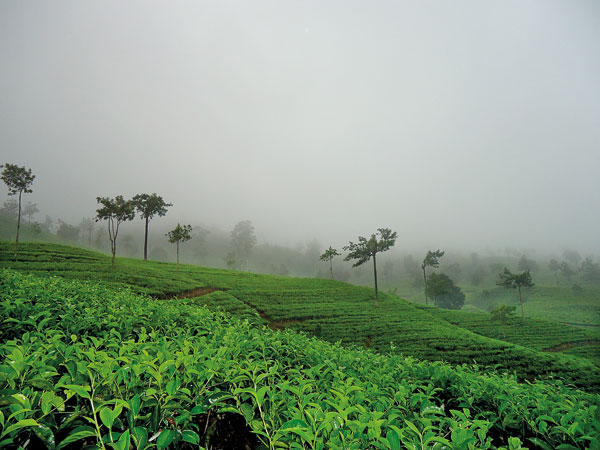News
First-ever study to gauge the carbon footprint from energy use in tea production
Breathless and chilled to the bone, he clambered up mist-laden hills, then staggered and slithered down again, after which he ventured into factories churning out those invigorating tea leaves.
For three years, Dr. JagathdevaVidanagama roamed the hills and valleys under challenging conditions – all for the benefit of the environment.
His efforts have paid off. He has produced the first-ever ‘cradle-to-gate’ lifecycle analysis (LCA) and carbon footprint of two valuable exports from Sri Lanka – tea and rubber. The carbon footprint is the total greenhouse gas (mainly carbon dioxide, methane and nitrous oxide) emissions, in this case by the tea and rubber industries, which contribute to climate change, over which the whole world is worried about.

Prof. Erandathie Lokupitiya
Cradle-to-gate, it is understood, is ‘origin-to-end’ and in the case of tea: Phase 1 – raw material extraction (plucking of leaves from the tea bushes); Phase 2 – transport of tea leaves to the factory; and Phase 3 – processing of the fresh leaves & dispatch of the final product.
However, without just being critical about these greenhouse gas emissions by the tea and rubber industries, Dr. Vidanagama who obtained his doctorate from the Department of Zoology and Environment Sciences of the University of Colombo under the supervision of Prof. Erandathie Lokupitiya, has also recommended mitigatory action.
This research had been funded by the National Research Council and the University of Colombo.
Prof. Lokupitiya says that the purpose of this research was to see how Sri Lanka’s main agricultural export products could play a role in the global market, as there is a tendency for the investors/buyers to go for cleaner, carbon neutral or carbon negative products.
“The speciality of this project is that we considered the carbon sequestration and emissions at plantation level and beyond until the product is out. We found that our key agricultural export products are mostly carbon negative. There should be a proper mechanism for labelling such agricultural products and the findings and recommendations of this research need to be given due consideration in policy decision-making,” she reiterates.
Referring to tea, Dr. Vidanagama explains that 40% of the plantations which are spread across the different regions of up, mid and low-country, come under Regional Plantation Companies (RPCs), while a bulk, 60%, are under smallholders.
Working far away from his base in Colombo, he had trudged the narrow and steep paths on tea plantations in areas such as Kandapola, Madolkelle, Madolsima, Dick Oya, Hatton, Namunukula, Talawakelle, Bogawantalawa, Deniyaya, Galle and Matara, while also visiting 70 factories.
“I did not work with secondary data, but collected primary data from the source. I visited the plantations and carried out random validation of the data,” he says, pointing out that while RPCs own tea plantations and also have their own factories, what happens with the smallholders is that their tea leaf is collected by private factory owners. This is mainly in the mid-country and low-country areas and these private owners use what is dubbed ‘bought leaf’ to produce tea in their factories.
The data collection had been from 2012-2016, with meticulous analysis from 2014-2017, with the emission of greenhouse gases being collated for each phase.
Dr. Vidanagama’s findings with regard to plantations of the RPCs were:
Phase 1 – raw material extraction (plucking of leaves from the tea bushes). As the plucking of the leaf is done manually, no energy was needed. However, the plantation offices used electricity (produced by thermal power) and some of the staff went around on motorcycles or other vehicles which ran on petrol or diesel.

Dr. JagathdevaVidanagama gathering data from the primary source of tea plantations
Phase 2 – transport of tea leaf to the factory. With lorries carrying out this task, there was use of diesel.
Phase 3 – processing of the fresh leaf & dispatch of the final product. Throughout this process, electricity was used (diesel in the event of a power-cut to run the generators) and in the leaf-drying section, it was firewood (solid fuel biomass) that was used.
He goes onto explain that while the diesel used in case of a power-cut to operate the generator was not of significance, the firewood (dara) used in the leaf-drying section produced some significant emissions of methane and nitrous oxide.
Looking closely at this aspect, Dr. Vidanagama had also found that dara was brought from as far away as the dry zone to the hill country,with a large quantum of diesel being required for such transport.
“In the past, the dara had been rubber wood from unproductive trees which were uprooted after 25 years. But now with value-addition to this rubber wood to make furniture, what is happening is that only 30% of the wood being used is rubber and the larger proportion of 70% is ‘jungle’ wood and also trees in home gardens,” he says, stressing that people are going into the jungle and felling trees from here and there to service the tea industry.
Dr. Vidanagama points out that in the long term, this would have an impact on the environment as not only is Sri Lanka burning solid fuel biomass which emits greenhouse gases but also cutting down trees which absorb carbon and release life-giving oxygen.

A mist-laden tea plantation, a primary source of data for the research
The mitigatory measures recommended by him for RPCs are:
Modify and modernize electricity-using equipment to be more energy efficient including the use of variable frequency drives for the leaf-withering process and energy efficient motors in other machinery.
Use renewable energy sources such as solar Pvs (photovoltaics), micro-hydropower from small waterfalls and wind power if there is potential, while maximizing daylight usage.
Marginal tea lands could also be used to produce energy crops (timber) so that a large quantum of wood need not be transported across distances.
Establish on marginal tea lands – where possible – a forest to absorb carbon dioxide.
| Stretching rubber to prevent climate harm Into the gloomy and snake-ridden rubber estates Dr. Jagathdeva Vidanagama journeyed to check out what this industry’s contribution is to the carbon footprint. He has estimated the cradle-to-gate lifecycle carbon footprint for the four main raw rubber products made from latex. These four products can be grouped once again into two –dry rubber products and centrifuged latex based products. Dry raw rubber products include crepe rubber which has a high value and quality (used in the manufacture of soles of shoes and other products) and Ribbed Smoked Sheet (RSS) rubber and Technically Specified Rubber (TSR) used in the manufacture of tyres, tubes and other household and industrial products. Centrifuged latex and its value-added products are used in the production of gloves, balloons, elastics, exercise equipment and foam mattresses. “Centrifuged latex and dry rubber-based value-added products use up much electricity and thermal energy,” says Dr. Vidanagama. To mitigate emissions that arise from electricity consumption, he offers three options: Increasing process and energy efficiency. Increasing the share of renewable energy (biomass or solar). Offsetting emissions by reforestation or afforestation. | |

